Prime Minister Review | Political Powerplay
Deeply thematic with mechanics I have never encountered.
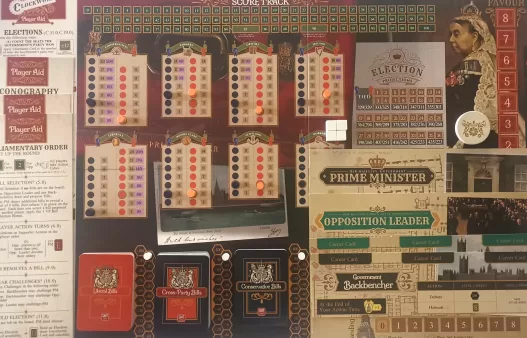
Let’s check out Prime Minister from GMT Games!
Introduction
I don’t know much about Victorian England except that they were led by Queen Victoria, arguably the best monarch or the British Empire; and that this was the time period when The Empire was at its largest and most powerful.
When I heard of the game, Prime Minister from GMT Games, where you play politicians vying for the position of PM, gain popularity with different constituents; debate and pass bills that may aid or hinder growth of different sectors; undermine party leaders and the Prime Minister himself – it just sounded so much like modern day politics in a box that I had to try it out myself.
What’s in the Box
Prime Minister is a game for 1 to 4 players. It comes in a 3 inch, sturdy box with great box art that really evokes the feel of Victorian England. The game comes with two rulebooks – one for regular multiplayer games and one for solo games against the game AI called Clockwork. These are the best quality rulebooks I’ve seen from GMT Games, with newspaper like pages; big, readable fonts; and lots of iconography and example illustrations throughout. Here’s hoping other GMT games adapt this kind of rulebook design.
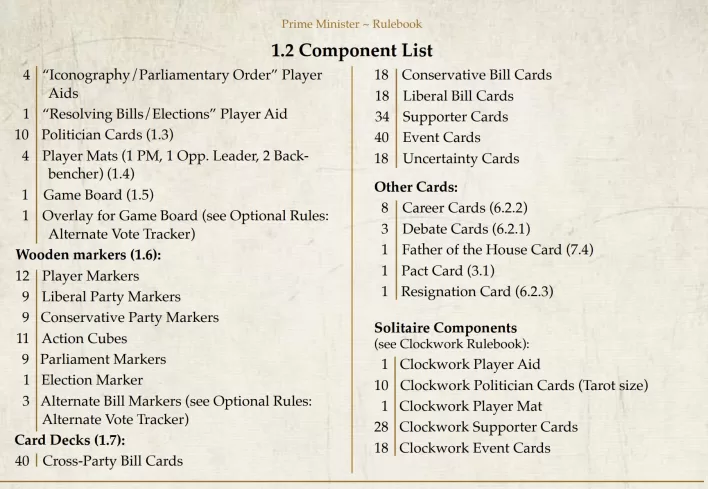
List of components from the game manual
The game comes with a 22×17 inch board, components for the dedicated solo mode, cards for Events, Politicians, Bills, Supporters and an Uncertainty Deck. It also has a myriad of wooden markers. All in all the components are numerous and of high quality and their graphic design and color palette does evoke a strong sense of theme.
Political Posturing
The game plays quite differently depending on player count, so I will just be describing the 4- player game.
The players setup the game as per rules and choose their Politicians. There should be 2 from the Liberal and 2 from the Conservative Parties. The Liberal side always starts in control of the Government and the politician with the lower number (on the upper left) will be Prime Minister and the other the Government Backbencher (aka 2nd in command}. Alternatively, the Conservative Politician with the lower number becomes the Opposition Leader and the other becomes the Opposition Backbencher. Each of them take their corresponding player mats, and place their player markers on the default Standing, which reflects how many Actions Cubes they will have.
The goal of the game is to reach 100 Victory Points (VP) while being the Prime Minister. Players gain VP by passing Bills and winning Elections and also by certain Events (such as By-Elections) which undermine the Prime Minister. The main job of the Prime Minister is to make sure Bills pass. Bills that fail to pass severely affect the Prime Minister’s Standing making him susceptible to a Challenge.
On the first turn, players choose a number of Bills and present their choices to the Prime Minister, who chooses 3 Bills presented to the House of Commons.
During a Turn, the Government Backbencher acts first, followed by Opposition players, then finally the Prime Minister. During their Action Turns, a player can play as many actions as they have Actions Cubes ( the Prime Minister usually has the most Action Cubes). They can Campaign, Debate, Hobnob or Gain Favor from the Queen.
A Campaign Action increases the popularity of the Politician’s party in one sector of society (ie middle class, farmers ). This also increases the Party’s chance of winning the next Election.
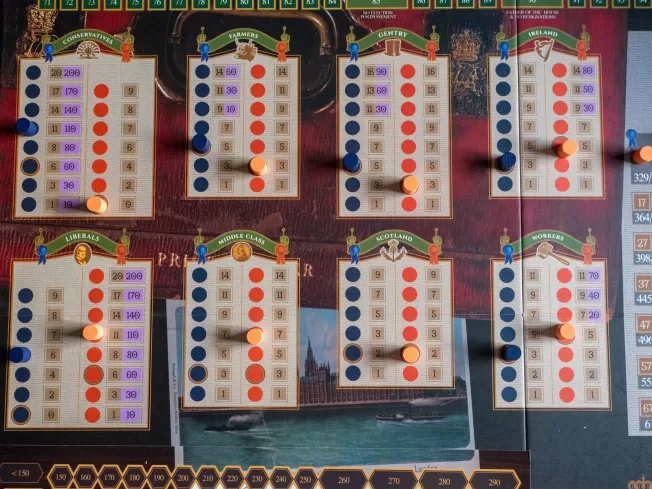
Campaigning in the Popularity Track is essential to winning Elections
A Debate Action can either increase or decrease the chance of a Bill’s passing depending on whether you want to undermine the Prime Minister or support his mandate. A Bill needs 330 votes from the House to pass.
A Favor Action increases a Politician’s favor with the Queen and act as a tiebraker; and are also important for Elections as sometimes Queen Victoria chooses to interfere in the Elections and appoints her favored Politician instead.
A Hobknob Action allows a player to draw Supporter Cards which are thematically popular figures of the era and provide different game effects. These cards can be used at once or kept for use in later rounds, adding strategic value.
At the start of a Prime Minister’s turn, he first draws an Event Card. These cards provide the Prime Minister with choices on how to react to the event by allocating 0 to 3 Action Cubes to resolve it. Allocating more Action Cubes to the Event will give more favorable outcomes but will leave the Prime Minister less Action Cubes to use.
Passing Bills and Elections
After his Action Turn, the Prime Minister needs to resolve one of the Bills. He has 3 choices: the Bill can pass by mutual agreement with the Opposition Leader (but the Opposition gains 5 VPs); the Prime Minister can choose to Withdraw a Bill (if he believes it has no chance of passing) in which he loses Standing and the Opposition Leader gains Standing and the Opposition Party gains 2 VP’s; or he can put the Bill to a vote. The Prime Minister draws an Uncertainty Card and applies this value (+ or -) to the Projected Votes of the Bill. If it reaches the 330 threshold, then the Bill passes and the Bill effects are applied (usually affects Popularity and VP’s), however the lower half of the Bill are effects reserved only for the Prime Minister and his party alone, which could be an increase in Standing, Favor of the Queen or popularity gains. If the Bill fails to pass however, the Prime Minister loses more Standing and the Opposition Leader gains more Standing aside from 3 VP’s for the Opposition side.
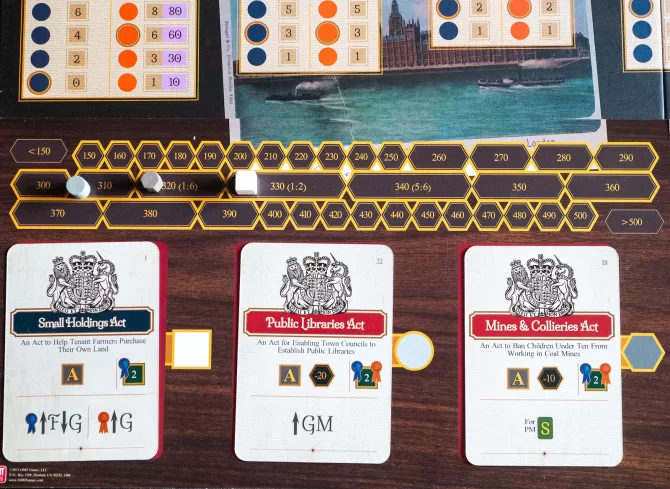
330 votes is the magic number to pass a Bill
After resolving Bills, players may challenge their party leaders or the Prime Minister himself if they have more Standing or equal Standing and as much Favor. The Prime Minister is then forced to resign and a new House of Commons is reconstituted.
If there was no successful challenge to the Prime Minister and no Bills are present at the end of the Challenge Phase, then an Election occurs. The Election Projection is used and an Uncertainty Card is drawn. The Party with the most number of votes has its leader elected Prime Minister and gains VP’s if a Government change occurred. However an Uncertainty Card may contain Queen Victoria’s intervention in which case she chooses her favorite as Prime Minister regardless of how the election went.
After an Election or successful Challenge, the House of Commons is reconstituted, showing the number of Majority Ministers of Parliament and the numbers of Moderates and Partisans, which are important is passing certain types of Bills.
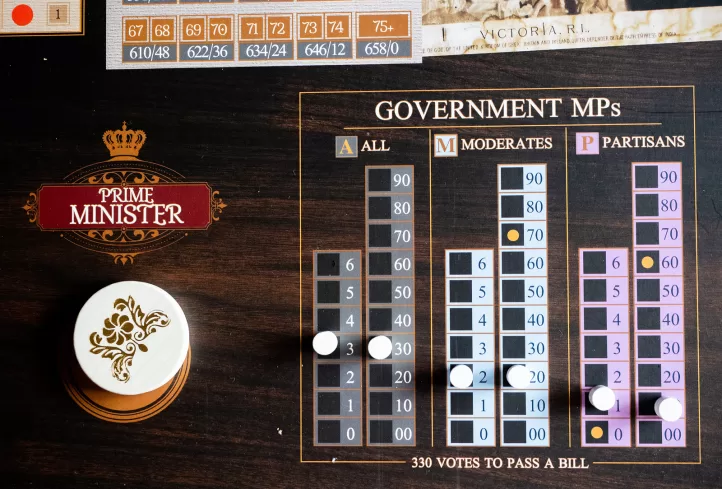
reconstituting the House of Commons after an Election
Play continues until one player has reached 100 VP’s while Prime Minister and he/she wins the game!
VP Pooling and Coo-petition
Prime Minister uses the unique mechanic of VP Pooling. At the start of the game, the Pact Card is active. This thematically illustrates a coalition government, with both parties working together. In game terms, all VP is shared during a Pact, and no action can be taken to undermine the Prime Minister, such as downvoting a Bill. During the course of the game, the Opposition may rescind the Pact, allowing them to attack Bills and directly oppose the Prime Minister’s mandate.
The Government Backbencher, can also Resign from the government, severely undermining the Prime Minister (he loses 2 Standing!) and opening the way to a Challenge. But the Backbencher should be careful when he does this, as a change in party leadership (even if it makes him Prime Minister) can severely weaken the party as a whole and can open an opportunity for the Opposition. The Prime Minister and Backbencher switch roles and the new Government Backbencher(the former Prime Minister) starts with a Standing of 0 and must work his way up to earn Career Cards which give him Actions as a Backbencher – without Career Cards, Backbenchers are very weak. So there is a subtle balance of coo-petition in the game. You want to personally gain Standing and VP, but you also don’t want to weaken your partymate too much or at the wrong moment, as it could present opportunities to the opposing side.
The Pact can be reestablished during certain conditions and the Backbencher can revoke his resignation also, allowing VP Pooling again. Players have to use these pooling mechanics wisely to keep then in contention or to pull away, which makes for a truly unique gaming experience.
There is much more nuance in the game which just cannot be covered fully in this review, but the game itself is easy to pick up and teach. Even casual gamers will find the rules and systems easy to grasp after a round of play. But for those interested there is a set of videos detailing the rules of gameplay which can be found here.
Different Game Different Player Counts
I’ve played the game at all player counts. Firstly, the solo mode called Clockwork is superbly done. It has its own components and rulebook and is easy to run once you’re familiar with the multiplayer game. You could, however, just jump straight into the solo rules and you will be fine understanding the clear, well crafted rules.
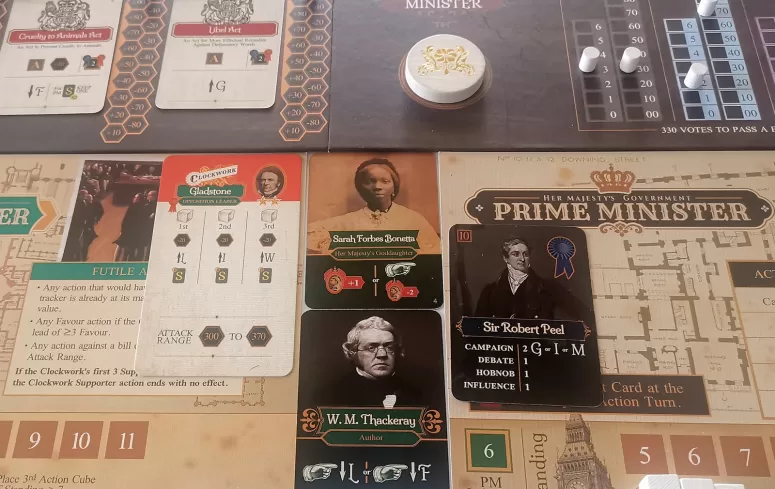
a solo game against the Clockwork AI, also shown are 2 Supporter Cards
Solo and 2-player games play more mathematical. You are optimizing your limited number of Actions to give you the most benefit. There is a strong push-pull element to the game, as your opponent tries to undo your actions and swing momentum in his favor.
At 3- or 4-player, it becomes harder to optimize as your own erstwhile allies plot against you and have their own agendas. Communication and negotiation become important tools. But unlike other negotiation heavy games, there is no resource exchange here. Instead you will be negotiating promises or board states, trying desperately to convince your Backbencher that attacking you now will be detrimental to the party as a whole. The VP Pooling and role swapping mechanics really shine in these player counts, and they are such unique game mechanics that I can’t say I’ve ever played a game like this. It really elevates the concept of coo-petition and game negotiation to a new level.
The Subtle Art of Politicking
Prime Minister is a great reflection of politics. You know that other politicians are out for your head, but you need to work with them still. You know you cannot be in office forever, so you have to make contingencies once your inevitable ouster comes to pass. You know your partymate will eventually undermine you, so maybe it’s time to sleep with the enemy. Your party leader is too strong, now may be the time to form a coalition with the opposition to bring him down. It truly embodies the line “Politics make strange bedfellows”.
Paul Hellyer, the game designer, also did well picking the Victorian England setting. By veering away from modern politics, he avoids the pitfall of possibly making the game too political or polarizing.
At first I was worried that the setting would not appeal to people (especially here in the Philippines), but as I played the game with gamers from different age groups, I saw them really engaged with the game. Asking them why they found the game appealing even if they knew nothing about 19th century politics, they said it somehow reflected our own politics. And I feel that’s another advantage of the game. It is a legislative and electoral game and any gamer who lives in a country that has elections and a parliament (or congress) will feel a sense of familiarity with the theme and systems.

even Millennials enjoyed the game
Being legislative and election focused is another unique selling point of the game. There are few games about the leader of a nation, and those tend to focus more on crisis management. I know of no other game (political or otherwise) that focuses on legislation, the interplay between politicians; and the correlation of popular sectors, elections and partisanship.
One lingering question though. Some players commented that when you switched roles to a Backbencher late in the game, there could possibly be no chance of you winning and you might be relegated to a kingmaker of sorts. I reached out to Paul Hellyer for his comment on this. He says that in many multiplayer games, there will be situations, especially late game, where certain players will have no chance of winning just as a function of it being a multiplayer game. He did add some late game catch up mechanics such as Father of the House but was reluctant to add more, as it may upset the whole game design. Instead, he added specific scenarios to address certain concerns (such late game Backbenchers) that players can explore after they familiarize themselves with the standard game.
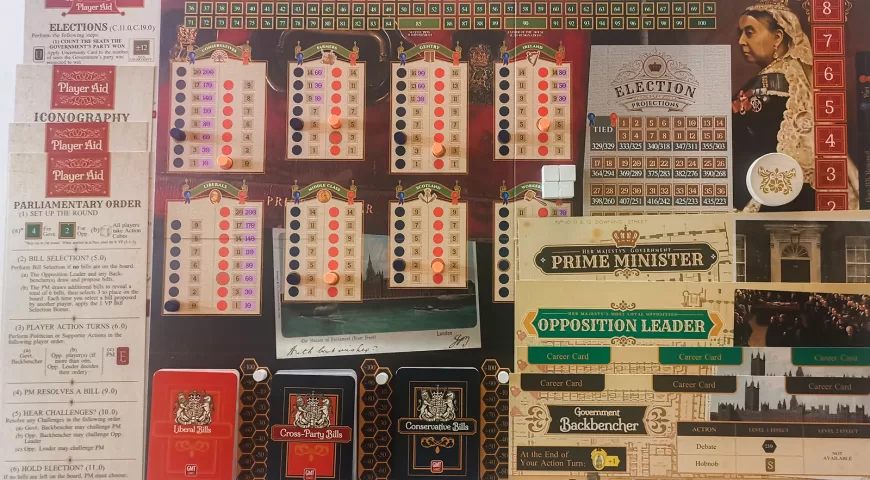
I have not, however, played any of these scenarios, but leafing through the rulebook, I do indeed see scenarios that address potential late game issues (Tournament Mode), scenarios for cooperative play, scenarios for solo against 2 Clockwork opponents, and sudden death alternatives. So aside from the standard game modes, there are a dozen or so scenarios for different player counts that will greatly extend gameplay aside from addressing possible balance issues.
Deeply thematic with mechanics I have never encountered, in a system that mixes mathematical optimization and social interaction and negotiation. Add to that good quality components, a dedicated solo mode, an easy to teach and play ruleset, scenarios that increase replayablity, and a decent playtime of 1 to 2.5 hours, make this game an easy recommendation to any game group.
Review Score: 8.75/10
Related:

